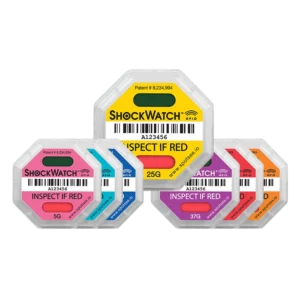
The History of Passive RFID Tags: How Did We Get Here?
Radio Frequency Identification (RFID) is one of the quickest growing technologies. In fact, if you work in industrial manufacturing or enterprise supply chain management, you probably already have RFID implemented in some form — security, tracking, payments, and the like.
Passive RFID enables data-rich communication plus, it’s compact and durable. It’s easy to deploy and it stands up to most conditions. With their affordability, passive RFID tags are a cost-effective way to enable data collection and tracking on a couple hundred objects, or a couple thousand — or million.
To better understand how passive RFID tags made their way into logistics and supply chain management via SpotSee’s innovative combo of impact recorder and RFID tracking tag — more on that later — it helps to understand how passive RFID technology came into the mainstream.
Earliest RFID Innovations
 The first documented RFID systems were during World War II. The German, British, Japanese, and American soldiers were all using radar to detect airborne aircraft. However, there was no way to differentiate between friendly and enemy planes.
The first documented RFID systems were during World War II. The German, British, Japanese, and American soldiers were all using radar to detect airborne aircraft. However, there was no way to differentiate between friendly and enemy planes.
The British, under the guidance of Sir Robert Alexander Watson, developed the Identification Friend or Foe (IFF) system. They fitted each British plane with a radio transmitter that reflected signals from British radar systems to identify the aircraft as friendly.
Passive RFID tags use a similar concept. A transponder picks up an incoming signal and automatically responds to the sending device. It’s the same mechanism used in RFID supply chain logistics.
RFID Innovation Post-World War II
Research about RFID communication systems continued after World War II. In the 1950s and 1960s, scientists for America, Europe, and Japan presented papers suggesting how RF technology could help identify objects remotely. The ideas opened the door for RFID commercialization.
Anti-Theft RFID Labels
One groundbreaking RFID innovation in the mid-20th century was Electronic Article Surveillance (EAS). In brick and mortar stores, the system detects radio frequency signals from a one-bit RFID tag attached to a product.
The bit stays on for unpaid items, and it’s turned off when a shopper pays for a product when checking out. If you attempt to exit the store with a product without paying, sensors at the doors read the tag and trigger an alarm.
RFID Door-Locking Systems

In 1973, Charles Walton invented a passive RFID tag to enhance security in door-locking systems. He added an RFID label to a key card and fitted a reader at the door. It’s only when the reader identified and validated the card the door would open. Since then, the key card system has become widespread in many modern buildings.
RFID Intellectual Property
Various researchers registered patents for their RFID innovations in the 1970s and the subsequent years. In January 1973, Mario W. Cardullo, an American engineer, earned a U.S. patent for the first passive RFID tags with a read and write storage.
In the same year, Charles Walton from California received a patent for his keyless, RFID-based door unlocking solution. He later licensed the technology to lock manufacturers, including Schlage.
Around the same period, the U.S. Energy Department requested scientists at Los Alamos National Laboratory to develop a tracking system for nuclear materials. The researchers found an answer in RFID labels.
The solution was attaching transponders to trucks and RF readers at the gates of protected facilities. An antenna at the gate would interrogate a transponder with a signal, which would respond with truck ID and driver details. The gates would open if the data matched that of the reader. This invention spilled over to toll gates.
The developers of the system left Los Alamos and commercialized their invention in the mid-1980s. They founded a firm that developed automatic toll payment systems. Such systems are available on roads, tunnels, and bridges across the world.
Passive RFID Tags in the Supply Chain
RFID technology has had a dramatic impact on supply chains over the past few years. With RFID labels and tags, logistics managers can track or verify the location of products right from the manufacturer to the consumer.
 But the latest entry in the RFID supply chain history book comes by way of SpotSee’s ShockWatch RFID. By combining its tried-and-true impact indicator technology with a passive RFID tag, SpotSee enabled asset tracking with built-in impact measuring — to inform handlers that damage may have occurred in transit.
But the latest entry in the RFID supply chain history book comes by way of SpotSee’s ShockWatch RFID. By combining its tried-and-true impact indicator technology with a passive RFID tag, SpotSee enabled asset tracking with built-in impact measuring — to inform handlers that damage may have occurred in transit.
What seems like a simple upgrade turns out to be revolutionary, allowing the leveraging of existing RFID infrastructure — installed at major investment by the company — to detect and pinpoint damage sources in their supply chains.
By upgrading RFID inventory management with impact indicators, SpotSee brings both passive RFID tags and supply chain management in general into a new era. Easy to install, passive, low-cost data transmission devices inform supply chain managers on the most opportune moments to improve their logistics operations.
Impacts, shocks, and intense vibrations can damage fragile items, electronics, and other devices. An impact monitor like ShockWatch RFID can report potentially destructive impact events. Plus, it provides visual indication to handlers by changing color when products undergo an undesired impact along the supply chain. Identified via RFID and plucked from inventory by an employee thanks to easy visual identification, users can isolate and inspect mishandled items.
Historic New Levels of Supply Chain accountability Thanks to RFID Innovations
Why is the combination of passive RFID tags used for inventory tracking and go/no-go impact indicators worth a spot in the history books?
Significant losses result from the mishandling of materials and products in the supply chain. RFID impact indicators can eliminate accountability issues by identifying where, when, and how severe of an impact occurred based on its location of scan.
Much like RFID told British pilots who and who not to aim towards, SpotSee’s ShockWatch RFID tells logistics managers exactly which shipments have been affected and where in the supply chain it occurred. Addressing possibly damaged assets before they’re put into further use can save all sorts of headache — and money.
Plus, the gains in supply chain efficiency and reliability due to the increased visibility of RFID impact indicators impact companies’ bottom lines on a grand scale, by helping highlight the most problematic handoffs.
If you’re ready to embrace the latest development in RFID for supply chain managers, fill out the form below. You’ll be connected with an RFID supply chain specialist to guide you towards cost-effective logistics optimization.


0 Comments on "The History of Passive RFID Tags: How Did We Get Here?"